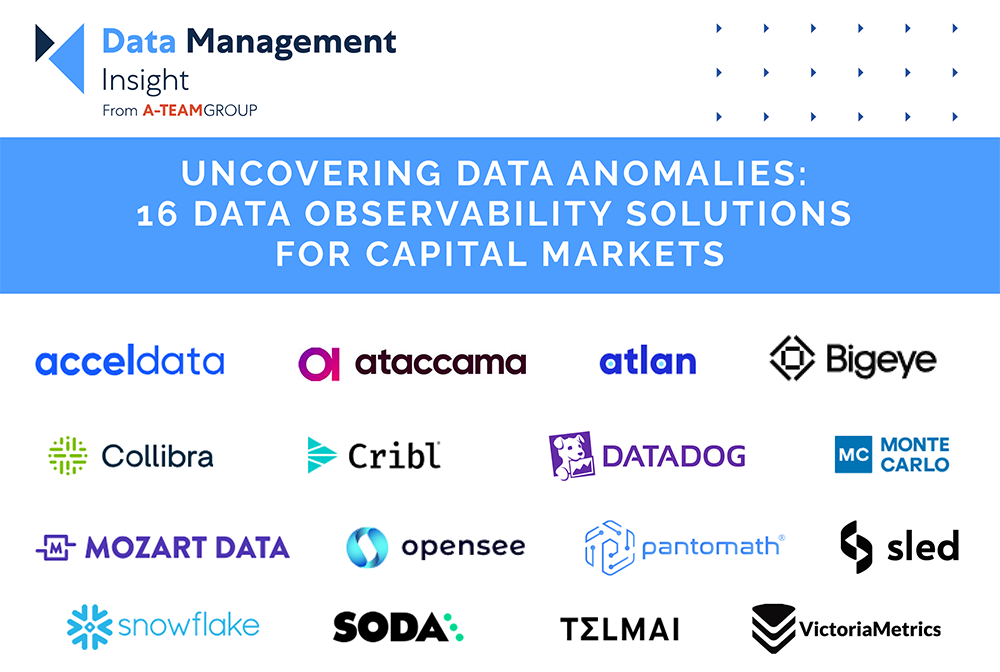
Financial institutions’ operational resilience depends largely on the integrity of their data and the applications it feeds. The huge volume of data that modern organisations ingest makes this a challenge. The accuracy, completeness and timeliness of critical data can be improved if it is monitored and checked as it moves through increasingly intricate data pipelines and diverse legacy systems. By detecting data anomalies, silent failures in data pipelines and issues with data quality, firms can avoid significant financial risks, reputational damage and regulatory penalties. Addressing these issues proactively, rather than reactively, has become a core concern for data professionals. This article profiles 16 vendors providing innovative data observability solutions – and observability-ready data processing – designed to tackle these challenges.
Winner of the Best Data Observability Provider Award at Data Management Insight Awards USA in 2024
Acceldata provides a unified data observability platform that is intended to help enterprises improve the reliability and performance of their data ecosystems. Its platform offers visibility into data quality, data pipeline performance and data infrastructure, enabling holistic data observability across diverse data sources and processing engines. Acceldata aims to help financial institutions proactively identify and resolve data quality issues, performance bottlenecks and operational inefficiencies within their data pipelines. In so doing, it prevents data-related outages and ensuring data reliability for critical operations, the company says.Winner of the Best Data Observability Provider Award at Data Management Insight Awards for Europe 2024
Ataccama’s AI-powered data management and governance platform packages data quality, master data management, data governance and data observability into a single offering. The company deploys AI and machine learning for automated data discovery and issue resolution. It has been created to assists financial institutions maintain high data quality standards and to gain comprehensive insights into data health across their data estate. This, it says, also reduces risks associated with poor data quality and facilitates regulatory compliance.
The collaborative data workspace created by Altan combines data cataloguing, data governance and data quality with its data observability features. Atlan boasts of its user-friendly interface and focus on collaboration, which its says enables data teams to understand, trust and govern their data, while integrated data observability provides real-time data health insights. These tools are designed to help financial institutions break down data silos and improve data literacy, enabling professionals to quickly identify and address data quality issues and ensure reliable data for analytics and reporting.
Bigeye’s data observability platform provides automated monitoring, anomaly detection and data quality insights along data pipelines. The platform uses machine learning and allows data teams to set up proactive alerts and understand data freshness, volume and distribution. Bigeye detects and alerts on data quality issues and pipeline failures, preventing erroneous data from affecting critical business processes and regulatory reports.
Collibra’s data governance platform includes capabilities for data cataloguing and data quality as well as data observability. Its end-to-end data governance framework provides a centralised system for managing data policies, definitions and quality, with observability features integrated to monitor data health. Collibra says its clients benefit from assistance in establishing a data governance framework that ensures their data is well-understood, trusted and of a high quality.
While not a traditional data observability platform, Cribl provides capabilities for organisations to process, route and transform data in motion, including data relevant for observability. This enables clients to control and enrich data to make it usable by observability tools, optimising data flow and reducing storage costs. In so doing, Cribl can help financial institutions manage high operational data volumes by intelligently routing and transforming it, ensuring that the right information reaches observability tools for monitoring and analysis, thereby reducing overall observability costs and improving data relevancy.
Datadog offers a monitoring and analytics platform that extends to data observability for applications and infrastructure. The company says its unified approach to observability allows financial institutions to correlate data issues with broader system performance and application health. This approach assists financial institutions in diagnosing and resolving data-related incidents by providing a holistic view of their technology stack.
Monte Carlo’s end-to-end data observability platform is designed to proactively monitor and alert on data quality and reliability issues. It facilitates machine learning-powered anomaly detection across entire data stacks, providing insights into data freshness, volume, schema changes and lineage. Financial institutions can prevent “bad data” from propagating through their systems by automatically detecting and diagnosing data incidents, reducing data downtime and ensuring trustworthy data for financial applications, according to Monte Carlo.
Through a platform that centralises data from various sources into a data warehouse, Mozart Data provides integrates features for data integration, transformation and light observability. The platform aims to be an all-in-one data solution for smaller data teams, simplifying the entire data stack from ingestion to analysis, including basic monitoring capabilities for data pipelines. This, Mozart Data says, ensures a foundational level of data visibility and reliability without the need for extensive engineering resources.
OpenSee provides a data observability platform that offers monitoring and anomaly detection for data pipelines and data quality. The offering focusses on providing a detailed view of data health across the entire data lifecycle, with robust capabilities for tracing data lineage, understanding data transformations and identifying data quality deviations. From the insights organisations gain into their data’s journey and health they can quickly pinpoint the source of data issues and ensure the accuracy and reliability of critical financial data.
Pantomath offers a data observability platform that provides visibility into data pipelines and data quality, focussing on proactive issue detection. Via end-to-end data lineage and dependency mapping, users can understand the impact of data changes and pinpoint the root cause of data anomalies across complex data ecosystems. In this way, Pantomath says institutions can achieve greater transparency in their data operations, allowing for rapid identification and resolution of data pipeline failures and quality issues, thereby maintaining data integrity for regulatory reporting and risk management.
Sled’s data observability platform focusses on improving data reliability and trust by offering proactive monitoring and alerting capabilities, which allow data teams to quickly gain insights into data freshness, volume and schema changes without extensive configuration. Clients can establish data reliability monitoring, ensuring that key data assets are consistent and accurate, which is important for operational stability and compliance.
While Snowflake doesn’t offer a standalone observability product, its cloud-native data platform that enables data warehousing, data lakes, data engineering, data science and secure data sharing supports data observability capabilities. Its all-in-one platform allows for integrated monitoring of data as it is ingested, transformed and analysed and it offers features that support data governance and lineage. Snowflake seeks to help financial institutions address data observability challenges by providing a scalable and flexible environment for data storage and processing, which inherently aids in tracking data freshness, volume and schema changes.
Providing a data quality platform with data observability capabilities, Soda enables organisations to define, monitor and improve data quality. Soda’s offering is built on a “data quality as code” approach that enables data teams to define data quality expectations as code and integrate data quality checks directly into their data pipelines and workflows. By empowering financial institutions to embed data quality checks throughout their data lifecycle, Soda says it can prevent bad data from entering downstream systems and ensure high-quality data for all business processes and regulatory requirements.
Telmai offers a data observability platform that provides automated anomaly detection and root-cause analysis for data pipelines. The technology leverages machine learning to automatically learn data patterns and detect anomalies in real-time, providing proactive alerts and insights into the underlying causes of data issues without extensive manual configuration. This enables the automation of detection of data quality problems and pipeline failures, reducing the time to resolution and ensuring the continuous flow of accurate and reliable data for critical trading and risk analytics.
VictoriaMetrics offers a monitoring solution and time series database, often used as a backend for observability platforms. While not a standalone data observability platform it provides the foundational time-series database optimised for metrics and logs. An enterprise version of its platform features anomaly detection and automated backups that are designed to help financial institutions manage and optimally store vast quantities of time-series data.
Subscribe to our newsletter



